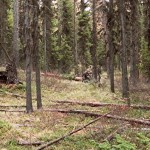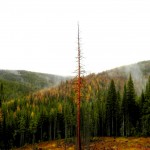
News/Reports
Gilnockie ER #104 Creek Photos by Greg Ross
Gilnockie Creek Ecological Reserve Warden Annie Coulter led the Rocky Mountain Naturalists on a field trip in the fall of 2010. We appreciate permission from Greg Ross to use his images from his Flickr site for this gallery. Hover your cursor on the small images for a title or commentary.
Greg has also provided useful information on the Reserve from this early ER booklet from BC Parks.
 ORIGINAL PURPOSE
ORIGINAL PURPOSE
To provide an undisturbed area for silvicultural research on western
larch, and a genetic bank for that species.
Fine, tall stands of mature, relatively disease-free western larch trees are the major feature of this reserve. The best growth by this shade-intolerant species is made on deep, porous, moist soils typical of much of the reserve. Both mature and immature larch stands are present. Tree diversity in the reserve is low, western larch and lodgepole pine providing almost all arboreal cover.
Two communities dominated by western larch occur here and both usually contain some lodgepole pine. In one type the understory dominants are low Oregon-grape, pinegrass, and cow-wheat; in the other soopolallie, common juniper and kinnikinnick are characteristic. Lodgepole pine stands with low Oregon-grape, silky lupine, and pinegrass also occur in small areas. Imperfectly drained sites support juvenile lodgepole pine, mountain alder, red-osier dogwood, and wild sarsaparilla.
Two communities have been described in a centrally located wetland which is surrounded by larch woods. The wettest is dominated by beaked sedge, bulbous water-hemlock, and aquatic mosses; the less saturated area by blue joint and trailing raspberry. Sweet marsh butterweed considered a very rare plant in British Columbia, occurs in the wetland.
Moose, elk, white-tailed deer and mule deer occur in this area, and one or more has heavily browsed willows and saskatoon berry. Birds noted in the reserve include the solitary vireo, American kestrel, ruffed grouse, spruce grouse, black- capped chickadee, red crossbill, evening grosbeak, Clark’s nutcracker and gray jay.
Larches are conifers in the genus Larix, in the family Pinaceae. Growing from 40-50 m or 115-150 ft tall, they are native to much of the cooler temperate northern hemisphere, on lowlands in the far north, and high on mountains further south. Larch are among the dominant plants in the immense boreal forests of Russia and Canada .
Although a conifer, the Larch is also a deciduous tree and loses its leaves in the fall. The name Tamarack is the Algonquian Native American name for the species.
UNIQUE FEATURES:
– Western Larch can grow for up to 850 years
– The larch is unique in that it has needles but also drops them like leaves in the fall
– The thick bark and its habit of shedding lower branches makes the Western Larch resistant to fire


















